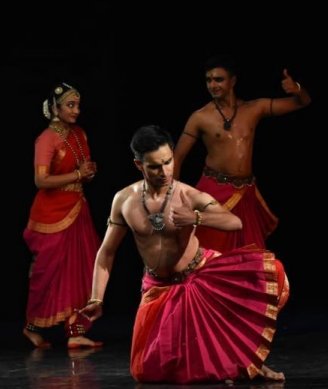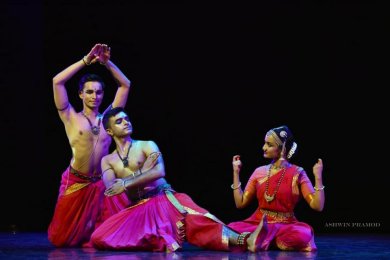
|   |

|   |
Dream premiere for Punyah Dance Company's Abha - Satish Suri e-mail: satishism@yahoo.co.in Photos: Ashwin Pramod December 27, 2018 Ramayana is a familiar story but creativity and innovation of Parshwanath Upadhye tweaked it to build a dance language that tells the story in a convincing manner. Abha, the story of Ramayana in a margam format, unfolded a creative process which had clarity, conviction and aesthetics as its fulcrum.The focal point of the narrative revolves around Sita,who is depicted as an incarnation of Goddess Lakshmi, and who made the choices in her life to complete the purpose of Vishnu destroying Ravana.The dutiful wife, the inner strength of her womanhood when she chose to go with Rama to the forest, she was the one who lifted the bow of Shiva and prayed that it should be so heavy when Ravana tried to lift and failed and light as a flower when Rama lifted it setting up the scenario for her marriage with Rama. She made the choice of crossing the Lakshman Rekha drawn by Lakshmana to protect her, to feed a brahmin asking for alms though it resulted in her being kidnapped by Ravana. She refused to go back with Hanuman and waited for Rama to rescue her after killing Ravana only to go through the test of chastity and later banished into the forest where she raised her two sons Luv and Kush. "I am the goddess. No one can abandon me. This forest is where I feel at home," says Sita. Finally Sita, the Kamalavasini, clearly defined the path she took of returning to earth to complete her responsibility.  The idyllic opening was set by the mellifluous sound of the flute as the three dancers, Parshwanath Upadhye, PV Aditya and Shruti Gopal, set the tone for a vibrant exposition of the alarippu through the Tulsidas bhajan "Mangala bhavana... Ram Siya Ram Jai Jai Ram" and the mnemonic syllables set the rhythmic scale of rigour and grace. The jatiswaram that followed showed the fine sense of rhythm and footwork, interspersed with pauses, the interlude of silence that translated into energetic body kinetics. The central piece of the narrative moved on to describe the birth of Sita and the celebration associated with it and as she grows, Rama sights her when playing and enquires about her. Her marriage to Rama, her going to the forest, her being taken away to Lanka by Ravana, her meeting with Hanuman were detailed with insightful references and myriad images that bought to life the stories and personalities in each segment of the narrative. The spatial movements and formations, the evocative expressions of the dancers, the artistically sensitive improvisation on stage provided a lyrical grandeur to the flow of the narrative registering a fine climax in nritta and abhinaya.The elaborate choreography, exacting rhythms and jathis and sancharis eloquently woven into the movements testified to the skill of the artists. Sita's role exemplified by a gamut of emotions, now coy, now angry, now shocked and anguished, now confident, had a breathtaking sublimity. Parshwanath as Rama and Aditya as Lakshmana provided delightful vignettes, playing with both rhythmic and expressive elements that added a special dimension to the presentation.  The narrative progressed detailing with delightful visual frames the unusual history of Luv and Kush and their interaction with Rama who realises that they are his sons. Sita questions the dharma rakshaka Rama, who pleads with Sita to return with him. Sita, however, decides to enter the Earth, having fulfilled her purpose. The concluding thillana,elaborate in its execution, had a fine sense of rhythm and footwork concluding with an ode to Sri Rangasai and "Bhagyadha Lakshmi Baramma" extolling Lakshmi. The beauty of the final freeze, the statuesque pose of Lakshmi and Vishnu resting on the Seshashayana captured to the lyrical strains of "Srimad Venkata Nathaya" enraptured the audience who burst into a standing ovation. The musical frame interlaced with verses in Mishra Awadh (Himanshu Srivastava), Sanskrit (Roopashri Madhusudhan) and Kannada with Rohit Bhat (vocal) supported by Jayaram KS (flute), Narayana Sharma (violin) and Harsha Samaga (mridangam),with Preethi Bharadwaj and Sharat TS (nattuvangam), embodied an aural landscape that gave the narrative a flow of amazing fluidity and intensity. Surabhi Bharadwaj and Avaneesh Darbe on the lights provided the subtle overtones and heightened effects. The presentation had a spectacle of grandeur that began with the music of nadaswaram players greeting the audience entering the auditorium of ADA Rangamandira, Bangalore, on Dec 14, 2018. The stage wings had banana stems as a decorative motif. The music ensemble was split on either side of the stage with the vocalist, flautist and violinist on one side and percussion ensemble and nattuvangam artist on the other side acting as a balance. An overflowing house exuberant in their appreciation had paid for watching this show; this was an endorsement of the inspirational brand of Parshwanath and Punyah Dance Company which augurs well for the future generation. Bangalore based Satish Suri is an avid dance rasika besides being a life member of the Music and Arts Society. |